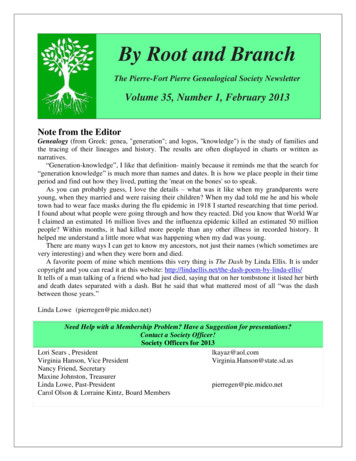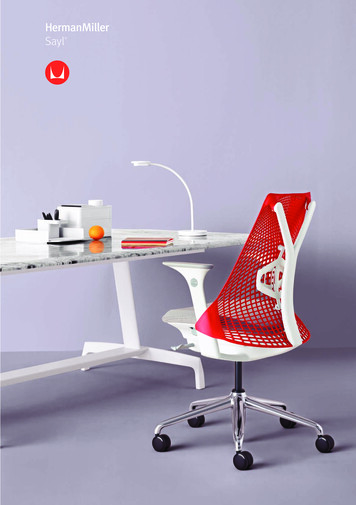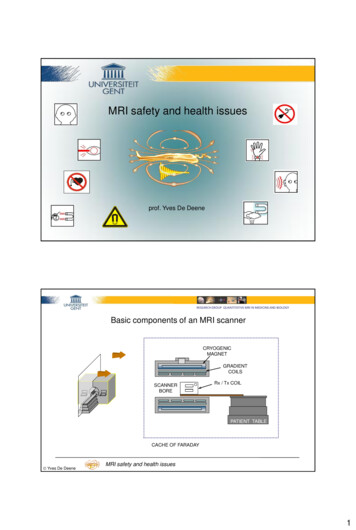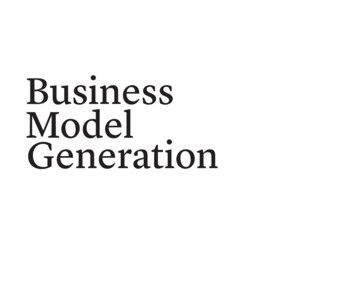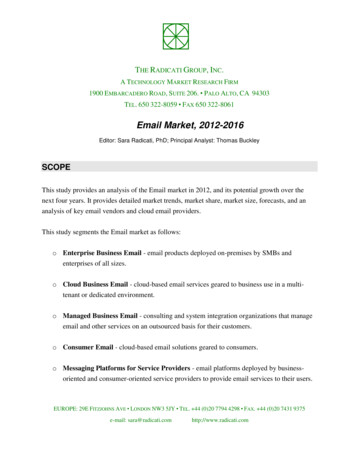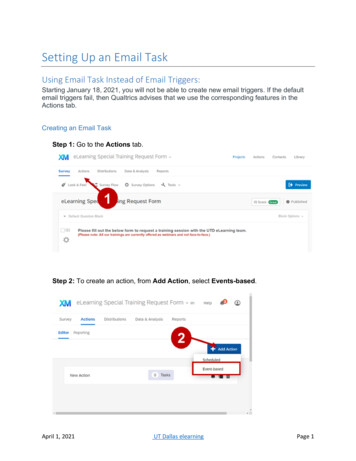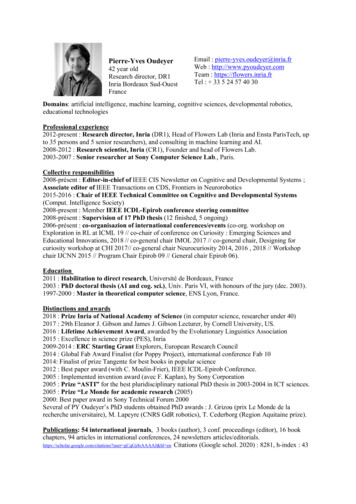
Transcription
Pierre-Yves Oudeyer42 year oldResearch director, DR1Inria Bordeaux Sud-OuestFranceEmail : pierre-yves.oudeyer@inria.frWeb : http://www.pyoudeyer.comTeam : https://flowers.inria.frTel : 33 5 24 57 40 30Domains: artificial intelligence, machine learning, cognitive sciences, developmental robotics,educational technologiesProfessional experience2012-present : Research director, Inria (DR1), Head of Flowers Lab (Inria and Ensta ParisTech, upto 35 persons and 5 senior researchers), and consulting in machine learning and AI.2008-2012 : Research scientist, Inria (CR1), Founder and head of Flowers Lab.2003-2007 : Senior researcher at Sony Computer Science Lab., Paris.Collective responsibilities2008-présent : Editor-in-chief of IEEE CIS Newsletter on Cognitive and Developmental Systems ;Associate editor of IEEE Transactions on CDS, Frontiers in Neurorobotics2015-2016 : Chair of IEEE Technical Committee on Cognitive and Developmental Systems(Comput. Intelligence Society)2008-present : Member IEEE ICDL-Epirob conference steering committee2008-présent : Supervision of 17 PhD thesis (12 finished, 5 ongoing)2006-présent : co-organisazion of international conferences/events (co-org. workshop onExploration in RL at ICML 19 // co-chair of conference on Curiosity : Emerging Sciences andEducational Innovations, 2018 // co-general chair IMOL 2017 // co-general chair, Designing forcuriosity workshop at CHI 2017// co-general chair Neurocuriosity 2014, 2016 , 2018 // Workshopchair IJCNN 2015 // Program Chair Epirob 09 // General chair Epirob 06).Education2011 : Habilitation to direct research, Université de Bordeaux, France2003 : PhD doctoral thesis (AI and cog. sci.), Univ. Paris VI, with honours of the jury (dec. 2003).1997-2000 : Master in theoretical computer science, ENS Lyon, France.Distinctions and awards2018 : Prize Inria of National Academy of Science (in computer science, researcher under 40)2017 : 29th Eleanor J. Gibson and James J. Gibson Lecturer, by Cornell University, US.2016 : Lifetime Achievement Award, awarded by the Evolutionary Linguistics Association2015 : Excellence in science prize (PES), Inria2009-2014 : ERC Starting Grant Explorers, European Research Council2014 : Global Fab Award Finalist (for Poppy Project), international conference Fab 102014: Finalist of prize Tangente for best books in popular science2012 : Best paper award (with C. Moulin-Frier), IEEE ICDL-Epirob Conference.2005 : Implemented invention award (avec F. Kaplan), by Sony Corporation2005 : Prize “ASTI” for the best pluridisciplinary national PhD thesis in 2003-2004 in ICT sciences.2005 : Prize “Le Monde for academic research (2005)2000: Best paper award in Sony Technical Forum 2000Several of PY Oudeyer’s PhD students obtained PhD awards : J. Grizou (prix Le Monde de larecherche universitaire), M. Lapeyre (CNRS GdR robotics), T. Cederborg (Region Aquitaine prize).Publications: 54 international journals, 3 books (author), 3 conf. proceedings (editor), 16 bookchapters, 94 articles in international conferences, 24 newsletters ations?user gCqGj4sAAAAJ&hl en Citations (Google schol. 2020) : 8281, h-index : 43
Keynote speeches at international conferences: Highlight : 2019 keynote at InternationalConference on Learning Representations (ICLR), WMLAI 2019, ReWork Deep Learning Summit2019, ICIS 2016, Evostar 2015, BICA 2015, Devoxx 2015, AAAI Spring Symposium 2014, WACAI2014, AAAI Fall Symposium 2013, AAMAS 2011, IEEE Alife 2011, Robolift 2011, Epirob 2009,Interspeech 2007.Technology transfer work and societal impact: 11 international patents (4 exploited commercially):http ://www.pyoudeyer.com/patents/2018-present: Coordination of transfer of curiosity-based personalization algorithms for educationalapps to edTech consortium of companies.2014-2018: Coordination of team who developed large-scale open-source educational roboticsprojects, including Poppy Education kits (http://www.poppy-education.org) and the Inirobot projectdisseminated to 25 000 schoolchildren in France, integrated in Main à la Pâte program ;https://goo.gl/u31gYE. This lead to the creation of Poppy Station (non-governmental association,http://poppy-station.org) and Pollen Robotics (start-up company, https://www.pollen-robotics.com) forlarge scale dissemination.2013-present: Head of the team who designed, developed and disseminated the Poppy Platform(http://www.poppy-project.org and) which is the first complete open-source 3D printed humanoidplatform in the world, for education, science and art. Poppy has been presented in highly visible andprestigious wide audience venues (François Hollande at Elysée, Axelle Lemaire in Bordeaux, Sénat,Le Web conference, Tedx Cannes), in numerous high quality media/press articles (full pages in LeMonde, Les Echos, Libération, interviews on France Inter, France Info as well as in international presssuch as Scientific American, El Mundo, japanese TV, https://www.poppy-project.org/in-the-press/ ). Itwas featured in the report of “Stratégie Nationale de Recherche France 2020”.2003-2018 : Curiosity-driven learning technologies used in Sony AIBO and Qrio commercial robots2009: Co-laureate of OSEO competition in “Emergence” category for the project of creation of a startup company in robotics.2005 – 2007: Collaboration with Sony Playstation Europe (SCEE London and Cambridge) for theintegration of my emotional speech synthesis technology (with associate patents, see patent section)into the standard audio libraries of Playstation 3.2002: Collaboration with the Speech and Audio group of the R&D department of Sony in Tokyo: theemotional speech synthesis technology I developed (see patents) were adapted and included in theSony Qrio humanoid robot speech system.1999 – 2006: Extensive collaborations with the Digital Creature Lab. from Sony in Tokyo, where theAIBO and Qrio robots were created. This allowed the transfer of a technology of playful interactions,called “clicker-training”, that I invented together with Frédéric Kaplan (and associated with a patent).Expertise and other committees2015-17: Expert for OPCST (French national assembly committee for evaluation of scientific andtechnological choices), French Senate and Academie des Technologies committees on artificialintelligence and ethical dimensions of digital technologies.2015-2016: Expert for Main à la Pâte foundation for the large scale educational project “1, 2, 3:Codez!” to teach computer science in primary schools.2005-present: Regular expert and reviewer for European Commission FP7 ICT, H2020 and FETprograms (selection of projects to be funded and yearly reviews of funded projects in AI, robotics,machine learning, language processing, assistive technologies).2010-present: Expert for the ANR (French national research agency) for AI and robot-relatedprojects.2011-present: Member of tenure track recruitment juries at Inria and universities.2011: Member of Jury “Prime d’excellence scientifique (PES CR)”, INRIA.2010-present: Member of “Comité des projets”, INRIA Bordeaux Sud-Ouest.2010-2014: Member of “Commission Developpement Technologique (CDT)”, INRIA Bordeaux SudOuest.2009: Secretary and member of “Groupe de reflexion sur la création potentielle d’un comité d’éthiqueà l’INRIA” (Committee for thinking about the creation of an ethical committee at INRIA).
2010-present: Jury of 34 PhD thesisPhD students (main supervisor, see details on http://www.pyoudeyer.com/phd-students/)Cédric Colas (co-supervision with O. Sigaud), Rémy Portelas (co-supervision with K. Hoffman),Alexander Ten, Sébastien Forestier (def. planned in 2019), Thibault Desprez (def. planned in 2019),William Schueller (2018, co-tutoring with Vittorio Loreto), Benjamin Clément (2018, co-supervisionwith M. Lopes), Florian Golemo (co-turoring with A. Courville), Alexandra Delmas (defended in 2018,co-supervision with H. Sauzéon), Fabien Bénureau (defended in 2014), Olivier Mangin (defended in2014), Thomas Cederborg (defended in 2014), Matthieu Lapeyre (defended in 2014), Jonathan Grizou(defended in 2014), Mai Nguyen (defended in 2014), Pierre Rouanet (defended in 2012), Adrien Baranes(defended in 2012).Teaching2016-present: Developmental machine learning course at Enseirb and ENSC Bordeaux2016-present: Developmental robotics course at CogMaster, ENS and Sorbonne Université2013-present: Design of educational resources for teaching computer sciences from primary schoolsto high-school (projects Inirobot and Poppy Education)2008 –2009: Irrcyn, Nantes, EMARO European Master on Advanced Robotics, “Social anddevelopmental robotics”, 15 hours/year.2006 – present: ENSTA, Paris, 3rd year engineering diploma, “Concepts and Algorithms for Socialand Entertainment Robots” (creation of the first course in developmental and social robotics inFrance, one of the first in Europe), 24.5 hours/year. regular punctual courses in several French universities and engineering schools.Popular scienceI have been strongly involved in popular science activities, involving regular writing of popular sciencearticles, participation to wide audience radio and tv programs and intervention in the press to addressscientific issues (e.g. Le Monde, Les Echos, France Inter, France Info, France Culture, ), participationto science festivals and museum exhibitions, and in particular coordinated the Ergo-Robot experiment,made in collaboration with moviemaker David Lynch, organized for 5 months during the exhibition« Mathematics : a Beautiful Elsewhere » at Fondation Cartier, Paris (50k ts/ ). I have also given in 2014 a TedX talk(https://www.youtube.com/watch?v AP8i435ztwE , video viewed by more than 16000 people).Selected list of popular science articles, videos and events: http://www.pyoudeyer.com/popular-science/Selected list of interventions in the press: http://www.pyoudeyer.com/press/Youtube channel: https://www.youtube.com/channel/UC7QuDF8AaE6mqEM9W S30RATwitter channel: https://twitter.com/pyoudeyer?lang enGrants obtained in the last 5 years- French ministry of education grant, Adaptiv’Maths, 2019-21, 200 keuros- DGA-Inria grant “DeepCuriosity for robust multi-goal Deep RL”, 110 keuros- Ubisoft/Région Aquitaine collaboration grant, “Unsupervised exploration in Deep RL3, 75 keuros.- Région Aquitaine project Curiosity-driven RL, 2019-23, 140 keuros- Microsoft PhD scholarship, 2018-21, 110 keuros- Inria ADT grant, “Infrastructure for Deep RL experiments”, 75 keuros- HFSP Neurocuriosity project, 2016-2019, 270 kdollars- Inria Neurocuriosity grant, from Inria, 2013-2019, 90 keuros- eFran Perseverons, 2016-2019, 146 keuros- DGA/Inria PhD grant, 2017-19, 59 keuros- Poppy Education, from Inria/Region Aquitaine/Feder, 2014-2017, 1000 keuros- Romeo 2, from FUI French founds, 2013-2016, 217 keuros,- Hybrid, from PEPS CNRS, 2014-2016, 10 keuros- KidLearn, from Inria/Region Aquitaine, 2015-2018, 129 keuros- ERC Starting Grant Explorers, 2009-2015, 1.5 millions euros
Summary of major scientific contributionsMy work has been focusing on the computational study, modelling and experimentation of lifelonglearning processes in machines and humans. This includes natural and artificial intelligence processesfor progressively and continuously discovering sensorimotor and language skills with high-dimensionalbodies. In particular, I have worked on the foundations of computational understanding of autonomouslearning and exploration, through my work on algorithmic models of curiosity-driven learning. I havebuilt a complete and unified research approach and framework identifying and studying interactingfamilies of guiding mechanisms which allow autonomous learners to collect efficiently informative datain the real world, and learn incrementally from it [J32, J25, J39, BC11]. This framework has been thebackbone of the research teams I created, first at Sony CSL Paris (2003,2007), then at Inria (2008present, 35 persons), supported by an ERC Starting Grant and various other prestigious internationalgrants. This work developed in a series of publications, with strong impact in several domains (detailsbelow): developmental robotics, machine learning and artificial intelligence [J10, J12, J13, J17, J18,J20, J4, J21, J28, J32, J34, J37, J41, J42, C84-87], educational technologies [J36, J44,C72] andpsychology and cognitive neuroscience [J6, J7, J8, J11, J14, J14A, J19, J25 J26, J33, J35, J39, J40,J44, J50].Curiosity-driven exploration algorithms in machine learning, robotics and artificial intelligence:Intrinsic motivations are mechanisms that drive spontaneous curiosity-driven exploration in animals andhumans, for whom they are central to organizing autonomous acquisition of novel skills and knowledge[J12, J13, J25, J31]. Together with my team and colleagues, I have played a leading role for introducing,formalizing and developing technically this concept in developmental robotics and artificial intelligence,showing its central importance for autonomous machine learning (i.e. learning of multiple tasks withoutintervention of an engineer for each task). At the international level, I pioneered the design andexperimentation of curiosity-driven learning algorithms in real world robots [C12, J12, J21]. Within aframework where machine learners incrementally learn predictive models of the world (world models)as they acquire new data, the main idea of curiosity-driven learning models consists in introducing anintrinsic task-independent cost function measuring the speed at which internal world models areimproving (e.g. decrease of prediction error), and use this cost function as the objective criterion to bemaximized while the learner is exploring its environment. More recently, we extended this researchprogram by introducing algorithms for autonomous goal setting, enabling machines to self-generate,self-select and self-order its own goals in order to maximize the quality of inverse models of the world[J21,C83,C87]. This lead to the successive elaboration of algorithmic architectures instantiating theseideas, based on formalisms combining reinforcement learning, population-based approaches and banditalgorithms (IAC [J10, J12], R-IAC [C29, C43], SAGG-RIAC [J21], McSAGG-RIAC [C25], SGIM[J27], SGIM-ACTS [J23], MACOB [C81], UGL-IMGEP [C83], CURIOUS [C87]), modelling variousmechanisms for empirical estimation of learning progress in synergy with complementary techniques(maturation [C25], learning by imitation [J23, J27], sensorimotor primitives [BC11], incrementalregression techniques for high-dimensions [C28]). They were experimentated in various real andsimulated robots, and with the collaboration of several colleagues and students, I showed that: 1)Intrinsically motivated exploration and learning of motor skills can be scaled to high-dimensional realworld robots [J12, J23, J27, J21]; 2) With only one general task-independent cost function a robot canlearn a diverse and organized repertoire of reusable motor skills [J25, J39], including through learningrepresentations of goal spaces with unsupervised deep generative models [C86]; 3) this enables to solvevery difficult deep reinforcement learning problems with rare or deceptive rewards [TR1,C85], as wellas to learn efficiently world models in high-dimensional robots [J21, J23, J27]. Impact: Thiscontribution played a central role in setting curiosity-driven learning (also called intrinsically motivatedlearning) as a central scientific topic in robotics, artificial intelligence, and machine learning. Inparticular, in the current blooming development of machine learning, these algorithms are becoming afundamental topic for autonomous learning, and large AI companies/labs use it to solve difficult deepreinforcement learning problems. The set of his articles related to this topic is cited 4000 times (source:Google scholar, 2018). I have been invited to give Keynote lectures on this topic at the followingconferences: ICLR (2019), WMLAI (2019), ReWork Deep Learning summit (2019), Evostar 2015(Denmark), Devoxx 2015 (France), BICA 2015 (France), AAAI Fall Symposium 2013 (US), AAAI
Spring Symposium 2014 (US), WACAI 2014 (France), AAMAS 2011 (Taipei), IEEE Alife 2011(France), Robolift 2011 (France).Computational theory of curiosity for developmental psychology and cognitive neuroscience. Theformalization and robotic experimentation of theories of intrinsic motivation led me and mycollaborators to propose the following novel insights and hypothesis back into these disciplines: 1)Fundamental aspects of developmental trajectories, defined as the successive formation of stages ofbehavioural and cognitive structures of increasing complexity, can be self-organised as a side-effect ofthe dynamical interactions between intrinsically motivated learning, the body and the environment [J44,J39, J33, J26, J25]; 2) In particular, the discovery and learning of elementary social skills such asimitation and the first steps of speech and language can be generated as a result of general mechanismsof intrinsically motivated learning [J39, J26]; 3) Empirical measure of learning progress in the braincould be achieved by dopaminergic circuits in the brain [J25, J14A]; 4) several of these hypotheses werevalidated through behavioural experiments in humans [J31, J44]. Impact: This work directly impactedresearch in psychology and neuroscience, with direct collaborations and joint publications with highprofile psychologists (e.g. Linda Smith, Indiana Univ.) and neuroscientists (Jacqueline Gottlieb, Univ.Columbia, NY, US, through the Neurocuriosity Associate team). These collaborations led to two majormilestone publications [J25, J50] presenting a unified theoretical landscape about curiosity inneuroscience and machines, published in a prestigious neuroscience and cognitive science journal(Nature Reviews Neuroscience, impact factor: 23; TICS, impact factor: 16,5). In this context, I also coinitiated and co-coordinated the organization of the First, Second and Third InterdisciplinarySymposium on Information Seeking, Curiosity and Attention (2014: Bordeaux; 2016: London, 150participants; 2018 Univ. Pennsylvania), and I am co-editor of a special issue on models of speechacquisition in the Journal of Phonetics. In 2012, I was awarded with C. Moulin-Frier the Best Paperaward (category models of cognitive dev.) at the IEEE ICDL-Epirob conference.Social, multimodal and language learning in robots, and applications to BCI. Complementingmechanisms of curiosity-drive learning, I have been developing and studying with my team severalalgorithmic approaches allowing robots to learn from the social guidance of non-engineer humans, aswell as to take advantage of multimodal information in such contexts, including: 1) probabilistictechniques that generalize imitation learning of a single motor skill to imitation learning of multiplemotor and language skills [J24, J30, J42]; 2) multimodal perceptual and language learning techniques,based on matrix factorization approaches, to detect invariants and associations in low-level flows ofspeech, video and movement [C39, C44]; 3) techniques combining active imitation learning andcuriosity-driven learning [J23, J27]; 4) techniques allowing a robot learner to simultaneously learn tointerpret the meaning of teaching signals and a task [C59, C60], and this found impact through agroundbreaking application in the domain of Brain-Computer Interfaces, where it allows to remove thecalibration phase in an important family of use cases [C62, C61], which is known to be a paramountchallenge in the field (this latter work was made through supervising J. Grizou’s PhD, who obtained theprize “Le Monde de la recherche universitaire” for the best PhD). I was co-editor of a special issue onbehavioural understanding in IEEE TAMD [J29].Models of language acquisition and evolution. I have also used algorithmic and robotic modelling asa tool to contribute to novel theories and understanding of language acquisition and evolution. Inparticular, I have developed a series of models and theoretical perspectives showing how coupledunsupervised learning mechanisms in local peer-to-peer language interaction could self-organize speechand language conventions at the scale of a population [J6, J7, J8, J11, J35, J39]. This has led to thewriting of a book published at Oxford University Press [B2]. This work is now reused and cited in thehuman language evolution literature and in associated textbooks [E161, E162]. Recently, I have shownwith my students how the dynamics of convergence of linguistic conventions in these models could beaccelerated by the use of active learning and teaching mechanisms [C76, C74]. For this series of work,I have received in 2016 the Lifetime Achievement Award from the Evolutionary LinguisticsAssociation.
Active teaching and applications to educational technologies. With my colleagues in the Flowersteam, we extended methods of active learning to methods of active teaching, allowing a software teacherto choose dynamically and incrementally an optimal sequence of teaching examples to maximize thelearning progress of a student: this naturally led us to design the KidLearn project, where the ZPDESalgorithm we designed was put in a tablet based tutoring system to teach elements of maths toschoolchildren and tested on a large scale in primary schools of Gironde (500 schoolchildren, 15schools). Doing this, we impacted the field of ITS through pioneering the use of Multi-armed banditsand cost functions based on empirical learning progress in the domain of Intelligent Tutoring Systems[C63, C66]. This technology is currently being transferred in companies for personalizing sequences ofexercises in smartphone educational application.Major contributions towards innovation and technology transferCuriosity-driven social robots. I am co-author of several international patents on curiosity-drivenlearning technologies [8,5], which have been used commercially in major Sony robotic products: theSony AIBO (https://en.wikipedia.org/wiki/AIBO) and Qrio robots (https://en.wikipedia.org/wiki/QRIO).Emotional speech synthesis and recognition. While I was working at Sony Computer Science Lab, Ideveloped several new technologies for emotional speech synthesis and emotional speech recognition,which led to several international patents and were integrated in several Sony products such as the Qriohumanoid robot and Playstation video games.Open-source 3D printed Poppy robot platform for education. I coordinated the team who designed,developed and disseminated the Poppy platform, which is the first complete open-source 3D printedhumanoid platform in the world: http://www.poppy-project.org [C71, C67, C54,C53]. The Poppyplatform was initially designed within my ERC Grant project, with the goal of developing anexperimental platform allowing the systematic scientific study of the role of morphology in sensorimotorskill acquisition (morphology can be changed easily and fastly). This has been a major innovation: thiswas before impossible because robot platforms were developed using classical machining techniquesrequiring a lot of time, energy and funding. Several research labs in Europe have already began to usethe Poppy platform for their own projects.As all aspects of the platform were designed to be highly modular, modifiable, robust, easily replicable,cheap, and accessible to beginners, this allowed us to apply and initiate its transfer towards educationin lycées, engineering schools and universities (around 20 lycées are now using the platform in standardCS courses, in collaboration with Rectorat and Canope educational institutions), but also FabLabs,science museums and art/science projects (4 dance companies are now using the platform in their officialperformances/shows). It is now becoming a major pedagogical innovation (Poppy educational robotickits are commercialized by the Generation Robots company), targeting education to the digital worldand its interaction with the physical world through integration of the robotic platform with software webtools to support the community ( 600 users on the Poppy forum) and with interdisciplinary pedagogicalcontent co-designed with users. No direct competitors exist so far. This led to the creation of the PollenRobotics start-up company, created in may 2016, which is now exploiting several of the technologiesdesigned in this project.
Selected publications[C94] Reinke, C., Etcheverry, M., & Oudeyer, P. Y. (2020). Intrinsically Motivated Discovery ofDiverse Patterns in Self-Organizing Systems. In Proceedings of International Conferenc on LearningRepresentations (ICLR).Portelas, R., Colas, C., Weng, L., Hofmann, K., & Oudeyer, P. Y. (2020). Automatic CurriculumLearning For Deep RL: A Short Survey. In Proceedings of IJCAI.Colas, C., Sigaud, O., Oudeyer, P-Y. (2019) CURIOUS : Intrinsically Motivated Modular, MultiGoal Reinforcement Learning, Proceedings of International Conference on Machine Learning (ICML2019).Gottlieb, J.,Oudeyer, P-Y. (2018) Towards a neuroscience of active sampling and curiosity, NatureReviews Neuroscience, 19(758–770).Laversanne-Finot, A., Péré, A., Oudeyer, P-Y. (2018) Curiosity Driven Exploration of LearnedDisentangled Goal Spaces, in Proceedings of Conference on Robot Learning, CoRL 2018.Colas, C., Sigaud, O., Oudeyer, P. Y. (2018). GEP-PG: Decoupling Exploration and Exploitation inDeep Reinforcement Learning Algorithms. In Proceedings of International Conference on MachineLearning (ICML 2018), arXiv preprint arXiv:1802.05054.Péré, A., Forestier, S., Sigaud, O., & Oudeyer, P. Y. (2018). Unsupervised Learning of Goal Spacesfor Intrinsically Motivated Goal Exploration. In Proceedings of International Conference on LearningRepresentations (ICLR 2018), arXiv preprint arXiv:1803.00781.Forestier S, Oudeyer P-Y. (2017) A Unified Model of Speech and Tool Use EarlyDevelopment. Proceedings of the 39th Annual Meeting of the Cognitive Science Society.Oudeyer P-Y., Gottlieb, J., and Lopes, M. (2016) Intrinsic motivation, curiosity and learning: theoryand applications in educational technologies Progress in Brain Research, 229, pp. 257-284.Oudeyer, P-Y. and Smith. L. (2016) How Evolution may work through Curiosity-drivenDevelopmental Process Topics in Cognitive Science, 1-11.Benureau, F., Oudeyer P-Y. (2016) Behavioral Diversity Generation in Autonomous ExplorationThrough Reuse of Past Experience, Frontiers in Robotics and AI, 3(8).Clement, B., Roy, D., Oudeyer, P-Y., Lopes, M. (2015) Multi-Armed Bandits for IntelligentTutoring Systems Journal of Educational Data Mining (JEDM), Vol 7, No 2.Mangin O, Filliat D, ten Bosch L, Oudeyer P-Y (2015) MCA-NMF: Multimodal ConceptAcquisition with Non-Negative Matrix Factorization PLoS ONE 10(10).Nguyen, M., Oudeyer, P-Y. (2014) Socially Guided Intrinsic Motivation for Robot Learning ofMotor Skills Autonomous Robots, 36(3), pp. 273-294.Baranes, A., Oudeyer, P-Y. (2013) Active Learning of Inverse Models with Intrinsically MotivatedGoal Exploration in Robots, Robotics and Autonomous Systems, 61(1), pp. 49-73. (#citations 2015 :74).
Moulin-Frier, C., Nguyen, S.M., Oudeyer, P-Y. (2014) Self-organization of early vocal developmentin infants and machines: the role of intrinsic motivation, Frontiers in Psychology (CognitiveScience), 4(1006).Lapeyre, M., N’Guyen, S., Le Falher, A., Oudeyer, P-Y. (2014) Rapid morphological explorationwith the Poppy humanoid platform, IEEE-RAS International Conference on Humanoid Robots, Nov2014, Madrid, Spain. pp.8.Grizou J., Iturrate I., Montesano L., Oudeyer P-Y., Lopes M. (2014) Calibration-Free BCI BasedControl, Proceedings of AAAI 2014.Gottlieb*, J., Oudeyer*, P-Y., Lopes*, M., Baranes, A. (2013) Information Seeking, Curiosity andAttention: Computational and Neural Mechanisms, Trends in Cognitive Science, , 17(11), pp. 585596. * identical contribution. (impact factor : 16.5).Oudeyer P-Y., Baranes A., Kaplan F. (2013) Intrinsically Motivated Learning of Real-WorldSensorimotor Skills with Developmental Constraints, in Intrinsically Motivated Learning in Naturaland Artificial Systems, eds. Baldassarre G. and Mirolli M., Springer.Cederborg, T. and Oudeyer, P-Y. (2013) From Language to Motor Gavagai: Unified ImitationLearning of Multiple Linguistic and Non-linguistic Sensorimotor Skills, IEEE Transactions onAutonomous Mental Development, pp. 222-239, 5(3).Nguyen, M., Oudeyer, P-Y. (2013) Active Choice of Teachers, Learning Strategies and Goals for aSocially Guided Intrinsic Motivation Learner, Paladyn Journal of Behavioural Robotics, 3(3):136–146.Rouanet, P. *, Oudeyer, P-Y. *, Danieau, F., Filliat, D. (2013) The Impact of Human-Robot Interfaceson the Learning of Visual ObjectIEEE Transactions on Robotics, 29(2), pp. 525-541. * joint 1stauthorsLopes M., Lang T., Toussaint M. and Oudeyer P-Y. (2012) Exploration in Model-basedReinforcement Learning by Empirically Estimating Learning Progress, Neural Information ProcessingSystems (NIPS 2012), Tahoe, USA.Lopes M., Oudeyer P-Y. (2012) The Strategic Student Approach for Life-Long Exploration andLearning in Proceedings of IEEE International Conference on Development and Learning andEpigenetic Robotics (ICDL-Epirob), San Diego, USA.Baranes, A., Oudeyer, P-Y. (2009) R-IAC: Robust intrinsically motivated exploration and activelearning, IEEE Transactions on Autonomous Mental Development, 1(3), pp. 155--169.Oudeyer P-Y, Kaplan , F. and Hafner, V. (2007) Intrinsic Motivation Systems for Autonomous MentalDevelopment, IEEE Transactions on Evolutionary Computation, 11(2), pp. 265--286. (#citationsmars 2015 : 497 // total citations on other articles on the same topic : 1656).Kaplan F. and Oudeyer P-Y. (2007) In search of the neural circuits of intrinsic motivation, Frontiersin Neuroscience, 1(1), pp.225--236.Oudeyer P-Y. and Kaplan F. (2007) What is intrinsic motivation? A typology of computationalapproaches, Frontiers in Neurorobotics, 1:6, doi: 10.3389/neuro.12.0
- Inria ADT grant, "Infrastructure for Deep RL experiments", 75 keuros - HFSP Neurocuriosity project, 2016-2019, 270 kdollars - Inria Neurocuriosity grant, from Inria, 2013-2019, 90 keuros - eFran Perseverons, 2016-2019, 146 keuros - DGA/Inria PhD grant, 2017-19, 59 keuros
